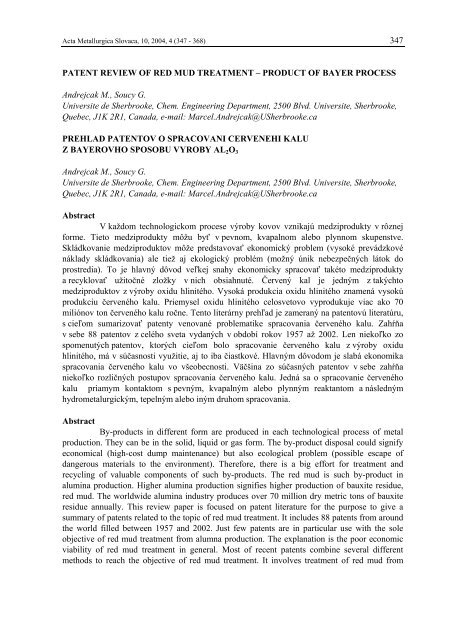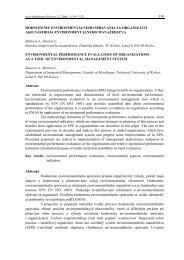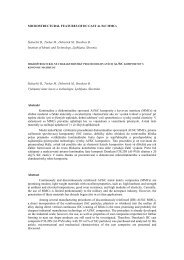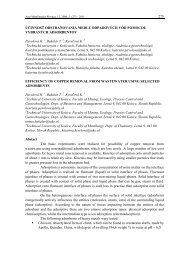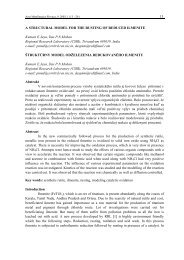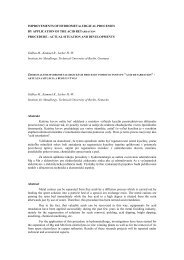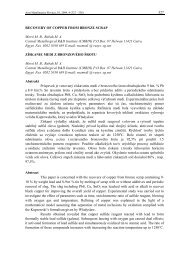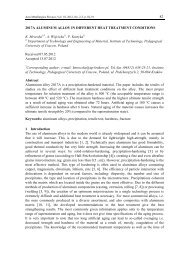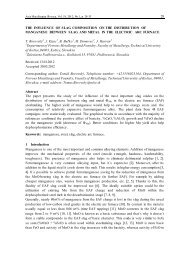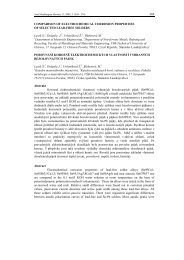PATENT REVIEW OF RED MUD TREATMENT–PRODUCT OF ...
PATENT REVIEW OF RED MUD TREATMENT–PRODUCT OF ...
PATENT REVIEW OF RED MUD TREATMENT–PRODUCT OF ...
Create successful ePaper yourself
Turn your PDF publications into a flip-book with our unique Google optimized e-Paper software.
Acta Metallurgica Slovaca, 10, 2004, 4 (347 - 368) 347<br />
<strong>PATENT</strong> <strong>REVIEW</strong> <strong>OF</strong> <strong>RED</strong> <strong>MUD</strong> TREATMENT – PRODUCT <strong>OF</strong> BAYER PROCESS<br />
Andrejcak M., Soucy G.<br />
Universite de Sherbrooke, Chem. Engineering Department, 2500 Blvd. Universite, Sherbrooke,<br />
Quebec, J1K 2R1, Canada, e-mail: Marcel.Andrejcak@USherbrooke.ca<br />
PREHLAD <strong>PATENT</strong>OV O SPRACOVANI CERVENEHI KALU<br />
Z BAYEROVHO SPOSOBU VYROBY AL2O3<br />
Andrejcak M., Soucy G.<br />
Universite de Sherbrooke, Chem. Engineering Department, 2500 Blvd. Universite, Sherbrooke,<br />
Quebec, J1K 2R1, Canada, e-mail: Marcel.Andrejcak@USherbrooke.ca<br />
Abstract<br />
V každom technologickom procese výroby kovov vznikajú medziprodukty v rôznej<br />
forme. Tieto medziprodukty môžu byť v pevnom, kvapalnom alebo plynnom skupenstve.<br />
Skládkovanie medziproduktov môže predstavovať ekonomický problem (vysoké prevádzkové<br />
náklady skládkovania) ale tiež aj ekologický problém (možný únik nebezpečných látok do<br />
prostredia). To je hlavný dôvod veľkej snahy ekonomicky spracovať takéto medziprodukty<br />
a recyklovať užitočné zložky v nich obsiahnuté. Červený kal je jedným z takýchto<br />
medziproduktov z výroby oxidu hlinitého. Vysoká produkcia oxidu hlinitého znamená vysokú<br />
produkciu červeného kalu. Priemysel oxidu hlinitého celosvetovo vyprodukuje viac ako 70<br />
miliónov ton červeného kalu ročne. Tento literárny prehľad je zameraný na patentovú literatúru,<br />
s cieľom sumarizovať patenty venované problematike spracovania červeného kalu. Zahŕňa<br />
v sebe 88 patentov z celého sveta vydaných v období rokov 1957 až 2002. Len niekoľko zo<br />
spomenutých patentov, ktorých cieľom bolo spracovanie červeného kalu z výroby oxidu<br />
hlinitého, má v súčasnosti využitie, aj to iba čiastkové. Hlavným dôvodom je slabá ekonomika<br />
spracovania červeného kalu vo všeobecnosti. Väčšina zo súčasných patentov v sebe zahŕňa<br />
niekoľko rozličných postupov spracovania červeného kalu. Jedná sa o spracovanie červeného<br />
kalu priamym kontaktom s pevným, kvapalným alebo plynným reaktantom a následným<br />
hydrometalurgickým, tepelným alebo iným druhom spracovania.<br />
Abstract<br />
By-products in different form are produced in each technological process of metal<br />
production. They can be in the solid, liquid or gas form. The by-product disposal could signify<br />
economical (high-cost dump maintenance) but also ecological problem (possible escape of<br />
dangerous materials to the environment). Therefore, there is a big effort for treatment and<br />
recycling of valuable components of such by-products. The red mud is such by-product in<br />
alumina production. Higher alumina production signifies higher production of bauxite residue,<br />
red mud. The worldwide alumina industry produces over 70 million dry metric tons of bauxite<br />
residue annually. This review paper is focused on patent literature for the purpose to give a<br />
summary of patents related to the topic of red mud treatment. It includes 88 patents from around<br />
the world filled between 1957 and 2002. Just few patents are in particular use with the sole<br />
objective of red mud treatment from alumna production. The explanation is the poor economic<br />
viability of red mud treatment in general. Most of recent patents combine several different<br />
methods to reach the objective of red mud treatment. It involves treatment of red mud from
Acta Metallurgica Slovaca, 10, 2004, 4 (347 - 368) 348<br />
alumina production by direct contact with solid, liquid or gas reactant and following<br />
hydrometallurgical, thermal or other kind of processing.<br />
Keywords: Red Mud, Treatment, Bayer Process, Patents<br />
Introduction<br />
The extraction of alumina as alumina trihydrate from bauxite is accomplished by the<br />
well – known Bayer process. The main characteristic is the digestion of the bauxite in caustic<br />
liquor. However, bauxite contains impurities, which are insoluble in caustic liquor and create<br />
insoluble residue known as red mud. The production of one ton of aluminium metal yields 1.5 to<br />
4 tons of a residue (on a dry basis) to be disposed. The worldwide alumina industry produces<br />
about 70 million dry metric tons of bauxite residue annually [1]. The red mud disposal could<br />
signify economical but also ecological problem. From the economics point of view it is<br />
potentially high life-cycle costs of future disposal, monitoring and uncertainty about total costs<br />
of residue disposal. From the ecological point of view it is production of large volumes of longterm,<br />
non-usable by-products, high alkalinity of mentioned by-product, potential for<br />
reclassification as a hazardous waste at some future time, potential of groundwater<br />
contamination, dusting during drying, higher than normal background radiation etc. These<br />
factors are the main reason of a big effort for treatment and recycling of valuable components<br />
from red mud.<br />
Chemical and Mineralogical Composition of Red Mud<br />
Red mud has a complex mineralization, which depends on the chemical and<br />
mineralogical composition of the processed bauxite and on the autoclaving conditions employed<br />
during the Bayer process treatment. It consists partly of minerals that do not dissolve during the<br />
caustic treatment of the bauxite and also of components originating during leaching (DSP). Red<br />
mud residue consists of minerals like hematite α−Fe2O3, goethite FeO(OH), boehmite<br />
Al2(OOH)2, gibbsite Al(OH)3, anatase or rutile TiO2, quartz SiO2, calcium carbonate and<br />
calcium aluminates from lime addition, and also of what is known as the desilication product<br />
(DSP), which contains not only silica but also considerable quantities of unrecovered alumina<br />
and soda. Desilication product plays a critical role in the Bayer plant process since it provides<br />
the mechanism for the removal of silica taken into solution during digestion by caustic soda.<br />
Chemically this is hydrated sodium aluminium silicate, approximating to the natural mineral<br />
Cancrinite. A common chemical formula assigned to this material is 3Na2O. 3Al2O3. 5SiO2.<br />
5H2O. Na2CO3. Universal agreement on a composition for this compound does not exist.<br />
Chemical composition of red mud residue depends on chemical composition of<br />
bauxite and on the amount of materials added into the Bayer process. Typical bauxite residues<br />
contain 24-50% Fe2O3, 12-30% Al2O3, 5-17% SiO2, 2-18% TiO2, 0.5-6% CaO, 3-10% Na2O.<br />
The residue also contains trace amounts of the metals gallium, zirconium, vanadium, thorium,<br />
scandium and rare-earth metals.<br />
Possible Red Mud Utilization<br />
Several methods are known for red mud utilization. This paper will focus on patent<br />
literature review. Patents issued between 1957 and 2002, from around the world were reviewed<br />
[2-88]. More than 88 patents were obtained, read and analysed. Number, date, author(s) and title
Acta Metallurgica Slovaca, 10, 2004, 4 (347 - 368) 349<br />
in table 1 classify the most pertinent patents during this period. They are presented in<br />
chronological order. The method, advantages and disadvantages described in each patent are<br />
also clearly summarised for potential readers.<br />
The patents can be divided into several categories according to red mud utilization:<br />
• Valorization: Recovery of sodium<br />
� Rare earth metals recovery<br />
� Oxides for ceramic industry<br />
� Metals, metal oxides, fluorides, chlorides<br />
• Construction, building material<br />
• Site restoration<br />
• Pigment<br />
• Steel production<br />
• Other (PVC, plastic material etc.)<br />
As is shown in Figure 1, the most of patents were focused on valorization of useful<br />
components contained in the red mud.<br />
steel production<br />
4%<br />
pigment<br />
4%<br />
site restoration<br />
6%<br />
construct.material<br />
23%<br />
other<br />
12%<br />
valorization<br />
51%<br />
Fig.1 Proportion of patents according to red mud utilization<br />
All the methods found in the patent literature can be summarized as follows:<br />
• Hydrometallurgical<br />
• Thermal + hydrometallurgical<br />
• Thermo – mechanical<br />
• Mechanical<br />
• Thermal<br />
• Other (ion–exchange, hydro–mechanical, magnetic separation, fluorination and<br />
chlorination, dissolving etc.)<br />
The chosen method of red mud treatment depends on its physicochemical properties<br />
and also on fact if it’s a complex utilization or an utilization focussed just on 1-2 components of<br />
red mud. Recovery of iron and steel has received the most significant attention in the past<br />
because of the dominant presence of iron oxide. Thermal methods like sintering, reduction<br />
smelting etc. has been widely examined. The main disadvantage of thermal methods is their big<br />
consumption of energy and economics would also require a low-cost technology for dewatering<br />
of the red mud. Processes aimed exclusively at utilization in iron metallurgy are economical<br />
only when high-content red muds are being processed.<br />
The mechanical or thermo-mechanical methods have been used mainly for production<br />
of building materials and ceramics. Processes aimed at utilization for building materials may
Acta Metallurgica Slovaca, 10, 2004, 4 (347 - 368) 350
Acta Metallurgica Slovaca, 10, 2004, 4 (347 - 368) 351
Acta Metallurgica Slovaca, 10, 2004, 4 (347 - 368) 352
Acta Metallurgica Slovaca, 10, 2004, 4 (347 - 368) 353
Acta Metallurgica Slovaca, 10, 2004, 4 (347 - 368) 354
Acta Metallurgica Slovaca, 10, 2004, 4 (347 - 368) 355
Acta Metallurgica Slovaca, 10, 2004, 4 (347 - 368) 356
Acta Metallurgica Slovaca, 10, 2004, 4 (347 - 368) 357
Acta Metallurgica Slovaca, 10, 2004, 4 (347 - 368) 358
Acta Metallurgica Slovaca, 10, 2004, 4 (347 - 368) 359
Acta Metallurgica Slovaca, 10, 2004, 4 (347 - 368) 360
Acta Metallurgica Slovaca, 10, 2004, 4 (347 - 368) 361
Acta Metallurgica Slovaca, 10, 2004, 4 (347 - 368) 362<br />
significantly ease storage problems, but is none the less only partial solution. The main<br />
disadvantage of these low-cost methods is that final products (bricks, constructional blocks,<br />
building material) comprise components (sodium content, radionuclides), which can cause<br />
significant problems in the future. The radiation concern represents an unacceptable commercial<br />
risk to making building products from the residue. Hydrometallurgical and thermo-mechanical<br />
methods are preferred in patents issued between 1990 and 2002. The situation is probably due to<br />
present cost effective technologies with less consumption of energy and due to complex<br />
utilization with significant reduction of red mud amount. Other methods like ion–exchange,<br />
hydro–mechanical, magnetic separation, fluorination and chlorination, dissolving are some kind<br />
of alternative methods usually used in combination with previous above mentioned methods.<br />
The methods found in the patent literature are schematically summarized in Figure 2.<br />
mechanical<br />
8%<br />
thermal<br />
7%<br />
thermomechanical<br />
22%<br />
other<br />
11%<br />
Fig.2 Methods of red mud treatment<br />
hydrometallurgical<br />
26%<br />
thermal+hydromet.<br />
26%<br />
Most of patents were issued between 1990 and 2002; some of them were refilled with<br />
upgrades. Improvements are often not very significant.<br />
Some of the methods quoted above, to the author’s knowledge, have been applied but<br />
all of them are still limited by economics (not cost effective technologies). No patent has seen<br />
worthwhile applications for the main purpose of red mud treatment. Proportion of patents<br />
according to time period shown in Figure 3 clearly demonstrates, that there is bigger effort to<br />
solve the problem of red mud residue in last decade.<br />
1990-1999<br />
34%<br />
2000-2002<br />
13%<br />
1980-1989<br />
22%<br />
Fig.3 Proportion of patents according to time period<br />
1957-1979<br />
31%<br />
The following investigation has been made for purpose to find out countries, which<br />
have publicized patents about red mud treatment. Almost all of these countries produce alumina<br />
from bauxite ore and have large amounts of untreated red mud. Proportion of issued patents by<br />
country is shown in Figure 4.
Acta Metallurgica Slovaca, 10, 2004, 4 (347 - 368) 363<br />
• Asia (Japan, China, Taiwan, Korea, India)<br />
• Hungary<br />
• Germany<br />
• Canada<br />
• Australia<br />
• USA<br />
• Russia<br />
• Other (France, Guyana, Guinea)<br />
Australia<br />
6%<br />
Russia<br />
6%<br />
U.S.A<br />
5%<br />
Canada<br />
9%<br />
other<br />
12%<br />
Germany<br />
13%<br />
Asia<br />
30%<br />
Hungary<br />
19%<br />
Fig.4 Proportion of issued patents by country<br />
Conclusions<br />
Most patents in use today were issued in the 80’s. Some of these patents are in partial<br />
use with the objective of red mud treatment or utilization. This situation most likely results from<br />
absence of feasible economic solution to this problem. The disposal of above mentioned byproduct<br />
could signify economical (high-cost dump maintenance), but also ecological problem<br />
(possible escape of hazardous substances to the environment). Upon prior research of many<br />
authors, the probable way in which to handle this problem is to combine different methods or<br />
combine treatment of suitable by-product mixtures, which would include red mud. To the<br />
authors of the recently written patent review, this appears as the most probable route to make red<br />
mud treatment process economically viable.<br />
Acknowledgments<br />
The authors gratefully acknowledge the financial support of Alcan International<br />
Limited, Le Conseil de Recherche en Sciences Naturelles et en Genie du Canada (CRSNG) and<br />
also Mr. Guy Forté for his comments and helpful suggestions.<br />
Literature<br />
[1] Technology Roadmap for bauxite residue treatment and utilization, The Aluminium<br />
Association, February 2000, 19 pages.<br />
[2] Barnett R.J., Mezner M.B.: Process for treating alumna-bearing ores to recover metal<br />
values therefrom., Goldendale Aluminum Company, Goldendale, WA, Int. Cl. C01G<br />
49/00, United States Patent, 6468483. 22.10.2002.<br />
[3] Siklosi P., Fejes P., Kiricsi I., Banvolgyi G.:Process for production of zeolites from raw<br />
materials containing alkali alumino hydro-silicates., Int. Cl. C01B 39/22, United States<br />
Patent, 6451282. 17.09.2002.
Acta Metallurgica Slovaca, 10, 2004, 4 (347 - 368) 364<br />
[4] Kim H. S.:Method for manufacturing artifical reef based on industrial waste., Int. Cl. A01K<br />
61/00, United States Patent, 6451722. 17.09.2002.<br />
[5] Shchukin V. S.:Method for reusing red mud-silica production waste., Int. Cl. C22 B 7/04,<br />
Russian Patent, 2179590. 20.02.2002.<br />
[6] Jha A., Antony M. P., Thathavadkar V. D.: Production of metal oxides., University of<br />
Leeds, Leeds, GB, Int. Cl. C01F 7/08, Australian Patent, 7646601, 13.02.2002.<br />
[7] Jha A., Antony M. P., Thathavadkar V. D.: Production of metal oxides., University of<br />
Leeds, Leeds, GB, Int. Cl. C01F 7/08, WO Patent, 02/10068, 07.02.2002.<br />
[8] Barnett R.J., Mezner M.B.: Process for treating alumna-bearing ores to recover metal<br />
values therefrom. Goldendale Aluminum Company, Goldendale, WA, Int. Cl. C01G 49/00,<br />
United States Patent, 6248302. 19.06.2001.<br />
[9] Lamerant J.M.: Process for recovering the sodium contained in industrial alkaline<br />
waste.,Aluminum Pechiney, Courbevoie, France, Int. Cl. B01D 15/04, United States Patent,<br />
6110377, 29.08.2000.<br />
[10] Kafka R., Vaskova H., Kusnierova M.:Method for treatment of waste red mud from<br />
aluminium production., Int. Cl. B 09B 3/00, SK Patent, 46698. 16.05.2000.<br />
[11] Ehntelis I. J., Orlov S. L., Smirnov B. N.:Process of recovery of rare-earth metals,<br />
scandium and yttrium, from red mud of alumina production., Int. Cl. C 22 B 59/00, Russian<br />
Patent, 2147623. 20.04.2000.<br />
[12] Na Ch. K., Lee M. S.:Manufacturing method of porous lightweight structural material using<br />
red mud., Int. Cl. C04B 18/16 ,Korean Patent, 240943. 02.03.2000.<br />
[13] Liu X., Jiao Z., Zhou D.: Red-mud sintered material., Shandong aluminium industry co.,<br />
CN, Int. Cl. C04B 18/14, CN Patent, 1225907. 18.08.1999.<br />
[14] Prince W., Poulin C., Aitcin P. C.: Reaction mixture for fabricating a binder from red mud<br />
and fluoroanhydride (Melange reactionnel servant a preparer un liant a partir de boue rouge<br />
et de fluoroanhydrite)., Universite de Sherbrooke, Sherbrooke, CA, Int. Cl. C04B 28/00,<br />
Canadian Patent, 2201822. 04.10.1998.<br />
[15] Nambiar N. R., Kumar A., Das Dinesh K., Banerjee G., Roy A. K., Sharma O. N.: Iron-rich<br />
cement clinker (Laitier riche en fer, ciment hydraulique et leur procede de preparation).,<br />
Council of scientific & industrial research, Bharat aluminium company ltd., IN, Int. Cl.<br />
C04B 7/345, FR Patent, 2760003. 28.08.1998.<br />
[16] Yao K.: Red mud recovery and utilization technology., Int. Cl. C02F 11/06, CN Patent,<br />
1164515. 12.11.1997.<br />
[17] Guitian Rivera F., Conde-Pumpido Touron R., de Aza Pendas S., Moya Corral J. S.::<br />
Process for producing heat-accumulator ceramic blocks from red mud clays of the Bayer<br />
process., Univesidade de Santiago de Compostela, 15705 Santiago de Compostela, ES, Int.<br />
Cl. C04B 35/66, European Patent, 0794161. 10.09.1997.<br />
[18] Picaro T.: Traitement des boues rouges (Red mud processing)., Queensland Alumina<br />
Limited, AU, Int. Cl. C01F 7/00, Canadian Patent, 2246528. 21.08.1997.<br />
[19] Picaro T.: Red mud processing (Traitement des boues rouges)., Queensland Alumina<br />
Limited, AU, Int. Cl. C01F 7/06, Australian Patent, 719126. 02.09.1997.<br />
[20] Picaro T.: Red mud processing., Queensland Alumina Limited, AU, Int. Cl. C01F 7/06,<br />
WO Patent, 9729992. 21.08.1997.<br />
[21] Williams G. M.: Treatment and disposal of red mud generated in the Bayer process., Ormet<br />
Corporation, Wheeling, w. Va., Int. Cl. B01D 24/46, United States Patent, 5607598.<br />
04.03.1997.
Acta Metallurgica Slovaca, 10, 2004, 4 (347 - 368) 365<br />
[22] Yuchang L., Liling Z., Zuolin L.: Sinter method for red mud dealkalization and surface<br />
modification treatment process., Shandong Aluminium Corp., CN, Int. Cl. C01F 7/46, CN<br />
Patent, 1141264. 29.01.1997.<br />
[23] Hong Ch. Y.: Process for the preparation of stabilized red mud., Korea General Chemical<br />
Ind. Co., KR, Int. Cl. C04B 18/04, Korean Patent, 9611325. 22.08.1996.<br />
[24] Komarov P. V., Poljakov M. S., Shilnikov A. J.: Method for recovery of aluminium,<br />
calcium and rare-earth metals from red mud., Proizvodstvenno-kommercheskaja firma<br />
“TNP-Indastri”, RU, Int. Cl.C01F 7/02, Russian Patent, 2048556. 20.11.1995.<br />
[25] Komarov P. V., Poljakov M. S., Shilnikov A. J.: Method for extraction of aluminium,<br />
calcium and rare-earth metals from red mud of alumna production., Proizvodstvennokommercheskaja<br />
firma “TNP-Indastri”, RU, Int. Cl. C01F 7/02, Russian Patent, 2034066.<br />
30.04.1995.<br />
[26] Wightman G.: Process for the removal of sodium values from sodium contaminated solids.,<br />
Davy McKee (Stockton) Limited, UK, Int. Cl. B01J 39/04, Canadian Patent, 2132638.<br />
03.02.1994.<br />
[27] Wilkening S.: Alumina recovery from material cont. aluminium and impurities of silicon,<br />
etc.-by selective removalof impurities by fluorination and chlorination to gaseous cpds.,<br />
saving energy and avoiding waste disposal problems., Int. Cl. C01F 7/20, DE Patent,<br />
4324428. 27.01.1994.<br />
[28] Zhongli L.: Red mud composite brick and its making method., Shanxi Aluminium Industry<br />
Cons., CN, Int. Cl. C04B 28/00, CN Patent, 1079452. 15.12.1993.<br />
[29] Allaire C.: Refractory material produced from red mud., Alcan International Limited, CA,<br />
Int. Cl. C04B 35/18, Canadian Patent, 1322009. 07.09.1993.<br />
[30] Csorba I., Fulop L., Kiss I., Lukonits O.: Method for recultivating red mud reservoir., Tatai<br />
Kornyezetvedelmi Rt., Tata, HU, Int. Cl. A62D 3/00, Hungarian Patent, 207804.<br />
30.08.1993.<br />
[31] Cardile C. M.: Process for the treatment of red mud., Alcoa of Australia Limited, Kwinana,<br />
AU, Int. Cl. C01F 7/06, WO Patent, 9316003. 19.08.1993.<br />
[32] Showa Denko KK, JP: Production of low-sodium red mud. Inventors: Kokoi H.; Int. Cl.<br />
C01F 7/06, JP Patent, 5170434. 09.07.1993.<br />
[33] Medvedev V. V., Tihonov N. N., Smorgulenko N. S., Zoldi J., Steiner J., Konig P., Csige<br />
J., Matyasi J., Fodor J., Feher I.: Process for producing sodium aluminate solutions with<br />
regener. sodium oxide and aluminium oxide content of red mud., Magyar Aluminiumipari<br />
Troszt, Budapest, HU, Int. Cl. C01F 7/02, Hungarian Patent, 207826. 28.06.1993.<br />
[34] Kawai M.: Method for utilizing red mud produced in aluminum refining process., Kawai<br />
Kaken Kogyo, Yugen, JP, Int. Cl. C01F 7/06, JP Patent, 5139727. 08.06.1993.<br />
[35] Allaire C.: Refractory material produced from red mud., Alcan International Limited,<br />
Montreal, CA, Int. Cl. C04B 35/10, United States Patent, 5106797. 21.04.1992.<br />
[36] Allaire C.: Refractory material produced from red mud., Alcan International Limited,<br />
Montreal, CA, Int. Cl. C04B 35/18, European Patent, 0318305. 31.05.1989.<br />
[37] Allaire C.: Refractory material produced from red mud., Alcan International Limited,<br />
Montreal, CA, Int. Cl. C04B 35/26, Canadian Patent, 1270863. 26.06.1990.<br />
[38] Allaire C.: Refractory linings capable of resisting sodium and sodium salts., Alcan<br />
International Limited, Montreal, CA, Int. Cl. C04B 35/18, Canadian Patent, 2017297.<br />
22.11.1991.
Acta Metallurgica Slovaca, 10, 2004, 4 (347 - 368) 366<br />
[39] Szirmai E., Babusek S., Balogh G., Nedves A., Horvath G., Lebenyi Z., Pinter J.: Method<br />
for the multistage, waste-free processing of red mud to recover basic materials of chemical<br />
industry., Aquatech Kernyezeteedelmi, HU, Int. Cl. C02F 11/00, United States Patent,<br />
5053144. 01.10.1991.<br />
[40] Pasztor D., Sudi Z., Vazsonyi I., Asboth J., Juhasz I., Lesenyei G., Miklos A., Molnar G.,<br />
Muhits T.: Method of red mud neutralization that falls off during aluminum oxide<br />
production., Melyepitesi Tervezo Vallal Fa., HU, Int. Cl. C01F 7/06, CS Patent, 274624.<br />
15.09.1991.<br />
[41] Chandler J. L., Noteboom D., Paradis R. D., Winch J. C.: Treatment of Bayer process red<br />
mud slurries., Alcan International Limited, Montreal, CA, Int. Cl. C02F 11/00, United<br />
States Patent, 5043077. 27.08.1991.<br />
[42] Fulford G. D., Lever G., Sato T.: Recovery of rare earth elements from Bayer process red<br />
mud., Alcan International Limited, Montreal, CA, Int. Cl. C01F 17/00, United States<br />
Patent, 5030424. 09.07.1991.<br />
[43] Szerecz J., Janaszik F., Lengyel B.:Process for producing iron-oxide pigment from red<br />
mud.: Int. Cl. C09C 1/24, Hungarian Patent, 202899. 29.04.1991.<br />
[44] Motomura I.: Treatment of red mud., Mitsubishi Heavy Ind. Ltd., JP, Int. Cl. C01F 7/06,<br />
JP Patent, 2111627. 24.04.1990.<br />
[45] Anashkin V. S., Yatsenko S. P., Skarin O. I., Diev V. N., Eremeev A. F., Klimentenok G.<br />
N.: Method of processing red mud of alumna production., Vni. Pi. Mekh. Obrabotki, Inst.<br />
Khim. Ural, Ural Vni. Pi. Alyuminievoj, SU, Int. Cl. C01F 7/00, SU Patent, 1505898.<br />
07.09.1989.<br />
[46] Andrews W. H.: Production of useful materials including synthetic nepheline from Bayer<br />
red mud., Comalco Aluminum Limited, Melbourne, AU, Int. Cl.C04B 33/04, United States<br />
Patent, 4810682. 07.03.1989.<br />
[47] Andrews W. H.: Production of useful materials including synthetic nepheline from Bayer<br />
red mud., Comalco Aluminum Limited, Melbourne, AU, Int. Cl.C01B 33/26, Canadian<br />
Patent, 1290920. 22.10.1991.<br />
[48] Cresswell: Recovery of sodium aluminate from Bayer process red mud., Comalco<br />
Aluminum Limited, Victoria, AU, Int. Cl.C01F 7/00, United States Patent, 4668485.<br />
26.05.1987.<br />
[49] Seigneurin L.: Method of recovering sodium aluminate contained in red mud., Aluminium<br />
Pechiney, Paris, France, Int. Cl.C01F 7/54, GB Patent, 2179931. 18.03.1987.<br />
[50] Baksa G., Boros J., Horvath G., Ihasz B., Pais Z., Rainiss M., Sitkei F., Solymar K., Toth<br />
B., Vallo F., Voro I., Orban nee Kelemen M., Zoldi J.: Process for the reduction of the<br />
sodium hydroxide losses of the Bayer-type alumna production., Magyar Aluminiumipari<br />
Troszt, Budapest, HU, Int. Cl.C01F 7/06, United States Patent, 4486393. 04.12.1984.<br />
[51] Czegledi B. G., Csovari M., Erdelyi M. S., Stocker L., Toth I., Szabo K., Riedeauer S.,<br />
Szentgyorgyi G.: Process for producing alumina and ferric oxide from aluminium carriers<br />
with high iron and silicon content., Tatabanyai Szenbanyak, HU, Int. Cl.C01F 7/22,<br />
Canadians Patent, 1176430. 23.10.1984.<br />
[52] Siegmund W., Bayer A. G.: Additive for road surface., Mannesmann Aktiengesellschaft,<br />
Germany, Int. Cl.C04B 31/20, Canadian Patent, 1174008. 11.09.1984.<br />
[53] Ritter G., Lenz U., Lazik P.: Method for treating red mud., Rheinische Braunkohienwerke<br />
AG, Cologne, Germany, Int. Cl.B01J 21/18, United States Patent, 4464479. 07.08.1984.
Acta Metallurgica Slovaca, 10, 2004, 4 (347 - 368) 367<br />
[54] Grzymek J., Derdacka-Grzymek A., Konik Z., Werynski B., Grzymek W., Olear Z.,<br />
Bogdanowicz K. B.: Process for the production of alkalis and titanium sulphate., Akademia<br />
Gorniczo-Hutnicza, Krakow, PL, Int. Cl.C01G 23/00, DE Patent, 3138054. 07.04.1983.<br />
[55] Puskas F.: Process for the utilization in the ceramics industry of red mud from alumna<br />
plants., Chemokomplex Vegyipari Gep-es Berendezes Export-Import Vallalat, Budapest,<br />
HU, Int. Cl. C04B 35/00, United States Patent, 4368273. 11.01.1983.<br />
[56] Hao P. L. C., Hsu W. W., Tang H. S.: PVC-red mud composition., Union Ind. Res. Labor,<br />
Taiwan, Int. Cl.B29C 29/00, Korean Patent, 8200555, 14.04.1982.<br />
[57] Bayer G., Siegmund W.: Red-mud based material for the construction of roadway<br />
coverings., Giulini Chemie GmbH, Ludwigshafen, DE, Int. Cl.E01C 7/18, European Patent,<br />
0048417. 31.03.1982.<br />
[58] Industrial Technology Research Institute, Taiwan: PVC-red mud composition. Inventors:<br />
Hao P. L. C., Hsu W. W., Tang H. S.; Int. Cl.C08L 27/06, Canadian Patent, 1111982.<br />
03.11.1981.<br />
[59] PVC-red mud composition., Union Industrial Research Laboratories, Taiwan, Int. Cl.C08L<br />
27/06, GB Patent, 1597424. 09.09.1981.<br />
[60] Hashida T., Kouno N.: Recovery method of iron ore raw material from red mud., Mitsui<br />
Arumina Seizo KK, JP, Int. Cl.C21B 15/00, JP Patent, 56077309. 25.06.1981.<br />
[61] Kainuma A.: Method of creating landfill from red mud., Nippon Light Metal Company<br />
Limited, Tokyo, JP, Int. Cl.B09B 5/00, United States Patent, 4270875. 02.06.1981.<br />
[62] Nippon Light Metal Company Limited, JP: Neutralizing method of red mud. Inventors:<br />
Mochizuki O.; Int. Cl.C02F 11/14, JP Patent, 55092200. 12.07.1980.<br />
[63] Harada G., Yen T., Tomari M.: Process for treating molten steel slag with red mud from<br />
aluminums industry. Nippon Jiryoku Senko Co., Ltd., Fukuoka, Japan, Int. Cl.C12B 3/04,<br />
United States Patent, 4179279. 18.12.1979.<br />
[64] Kitaoka K.: Method of separating silica, titania and alumna from red mud., Int. Cl.C01B<br />
33/12, JP Patent, 54137499. 25.10.1979.<br />
[65] Hao P. L. C., Hsu W. W., Tang H. S.: PVC-red mud compositions., Industrial Technology<br />
Research Institute, Taiwan, Int. Cl.C08K 3/22, United States Patent, 4161465. 17.07.1979.<br />
[66] Lakatos T., Miskei M., Szolmoki J., Toth F., Revesz L.: Process for the selective separation<br />
of the bound sodium content of red mud., Aluminiumipari Tervezo es Kutato Intezet, HU,<br />
Int. Cl.C22B 26/10, United States Patent, 4133866. 09.01.1979.<br />
[67] Zimmer E., Nafissi A., Winkhaus G.: Reclamation treatment of red mud.,<br />
Kernforschungsaniage Julich, Vereinigte Aluminum-Werke Aktiengesellschaft, Germany,<br />
Int. Cl.C01G 23/06, United States Patent, 4119698. 10.10.1978.<br />
[68] Zimmer E., Nafissi A., Winkhaus G.: Reclamation treatment of red mud.,<br />
Kernforschungsaniage Julich, Vereinigte Aluminum-Werke Aktiengesellschaft, Germany,<br />
Int. Cl.C01F 7/26, DE Patent, 2653762. 08.06.1978.<br />
[69] Kernforschungsaniage Julich, Vereinigte Aluminum-Werke Aktiengesellschaft, Germany:<br />
Reclamation treatment of red mud. Int. Cl.C22B 7/00, GB Patent, 1538628. 24.01.1979.<br />
[70] Process for the utilization in the ceramics industry of red mud from alumna plants., Chem.<br />
Vegypari Gep es Berendez, Aluterv Aluminiumipari Tervezo Vallalat, HU, Int. Cl.C04B<br />
35/00, GB Patent, 1491432. 09.11.1977.<br />
[71] Hrishisekan K. G.: Process for recovering soda and alumna values from red mud., Reynolds<br />
Metals Company, Richmond, USA, Int. Cl.C01F 7/08, United States Patent, 4045537.<br />
30.08.1977.
Acta Metallurgica Slovaca, 10, 2004, 4 (347 - 368) 368<br />
[72] Thakur R. S., Sant B. R., Muralidhar J.: A process for the recovery of vanadium as<br />
adoduim vanadate from bauxite residue (red mud)., Council Scient. Ind. Res., IN, Int.<br />
Cl.C01G 31/00, IN Patent, 142763. 27.08.1977.<br />
[73] Shiao S. J.: Method of activation of red mud., Int. Cl.B01J 37/02, United States Patent,<br />
4017425. 12.04.1977.<br />
[74] Dobos G., Felfoldi Z., Horvath G., Kaptay G., Osvald Z., Solymar K.: Method for the<br />
treatment of red mud., Magyar Aluminiumipari Troszt, Budapest, HU, Int. Cl.C21B 5/04,<br />
United States Patent, 3989513. 02.11.1976.<br />
[75] Iwu G. O.: Method of treating bauxite waste red mud with acid and making construction<br />
bricks from the treated material., University of Guyana, Georgetown, Guyana, Int. Cl.C04B<br />
35/00, United States Patent, 3985567. 12.10.1976.<br />
[76] Process for reducing the sodium content of red mud.,Tatabanyai Szembanyak AK, HU, Int.<br />
Cl.C22B 1/00, GB Patent, 1412040. 29.10.1975.<br />
[77] Bayer G., Cherdron E., Haerter M., Hecht E.: Method for producing bricks from red mud.,<br />
Gebr. Giulini GmbH, Ludwigshafen, Germany, Int. Cl.C04B 33/32, United States Patent,<br />
3886244. 27.05.1975.<br />
[78] Bayer G., Cherdron E., Haerter M., Hecht E.: Method for producing bricks from red mud.,<br />
Gebr. Giulini GmbH, Ludwigshafen, Germany, Int. Cl.C04B 33/04, United States Patent,<br />
3886245. 27.05.1975.<br />
[79] Dobos G., Felfoldi Z., Horvath G., Kaptay G., Osvald Z., Solymar K.: Method for the<br />
reduction treatment of red mud., Aluminiumipari Troszt, Budapest, HU, Int. Cl.C01F 7/04,<br />
United States Patent, 3876749. 08.04.1975.<br />
[80] Brick production., Gebruder Giulini GmBH, Germany, Int. Cl.C04B 35/18, GB Patent,<br />
1373441. 13.11.1974.<br />
[81] Dobos G., Felfoldi Z., Horvath G., Kaptay G., Osvald Z., Solymar K.: Procede de<br />
traitement de boue rouge., Magyar Aluminiumipari Troszt, Budapest, HU, Int. Cl.C01F<br />
7/02, FR Patent, 2187694. 18.01.1974.<br />
[82] Kapolyi L., Lazar F., Galauner B., Dzsida L., Vamos G., Wagner L., Pogany A.: Method<br />
for processing of red mud., Tatabanyai Szenbanyak, Tatabanya, HU, Int. Cl.C21B 13/08,<br />
United States Patent, 3776717. 04.12.1973.<br />
[83] Tsai J. H.: Process for the separation of useful compounds from waste of the aluminums<br />
industry., Int. Cl.C01B 33/00, United States Patent, 3574537. 13.04.1971.<br />
[84] Atsukawa M., Nishimoto Y., Iwaiya Y., Kuwabara H.: Process of recovering valuable<br />
components from red mud., Mitsubishi Shipbuilding & Engineering Company Limited,<br />
Tokyo, Japan, United States Patent, 3311449. 28.03.1967.<br />
[85] A process of separately recovering aluminium, iron and titanium values from material such<br />
as red mud containing said values, Blancs de Zinc de la Mediterranee, France, Int. Cl.C01F,<br />
GB Patent, 848230. 14.09.1960.<br />
[86] Process for the separation of iron, aluminium and titanium values from materials containing<br />
them., Strategic-Udy Metallurgical and Chemical Processess Limited, Ontario, CA, Int.<br />
Cl.C01G, GB Patent, 843607. 04.08.1960.<br />
[87] Improvements in or relating to the manufacture of steel., Mannesmann AG, Germany, Int.<br />
Cl.C21B, GB Patent, 769957. 13.03.1957.


